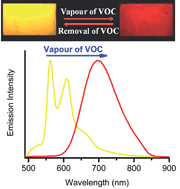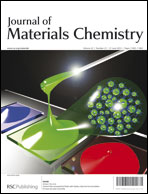Luminescence vapochromism in solid materials based on metal complexes for detection of volatile organic compounds (VOCs)
Abstract
Vapoluminescent materials that display reversible and naked eye perceivable colour or luminescence changes have been used as sensors for detection of volatile organic compounds (VOCs) which are toxic air pollutants. This feature article highlights recent advance in finding luminescence vapochromic solid-state materials based on d6, d8 or d10 metal complexes. It has been demonstrated that vapour-triggered luminescence colour changes are mostly relevant to a variation of weak interactions such as metal–solvent bonds, metallophilic contacts, π–π stacking, hydrogen bonding, host–guest affinity or reversible isomerization etc.


 Please wait while we load your content...
Please wait while we load your content...